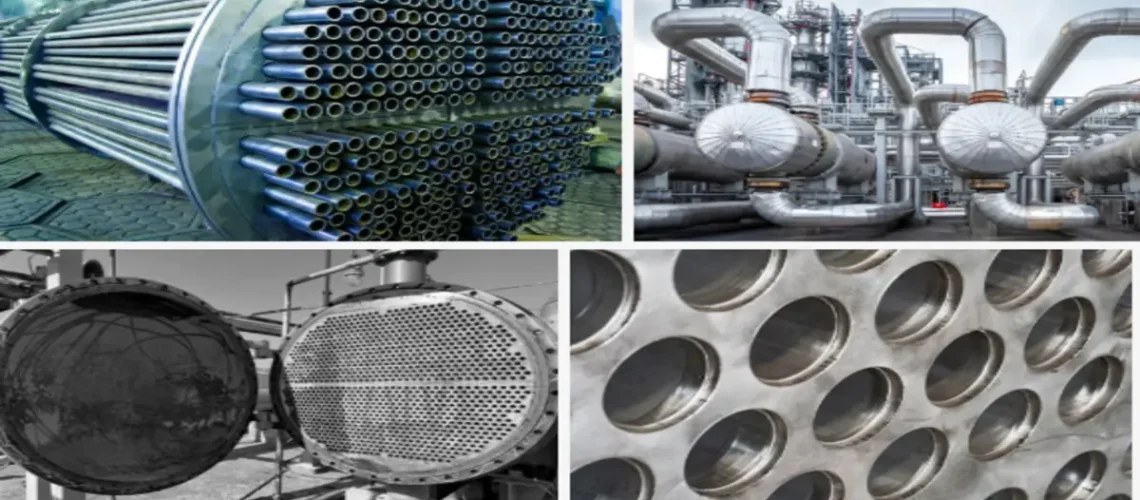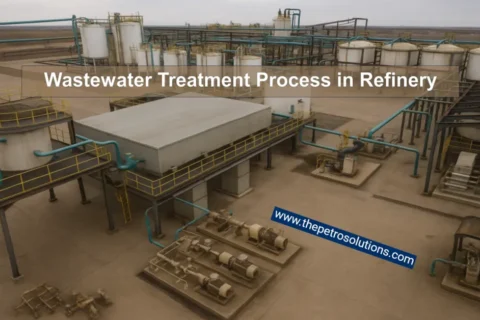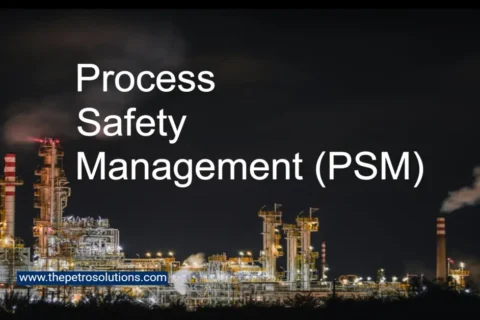Shell and tube heat exchangers are vital for effective, safe heat transfer in the process industry. Their design, versatility, and adherence to standards like TEMA and API 660 ensure their use in petroleum refineries, power plants, and chemical facilities. By understanding their components, heat transfer principles, and maintenance needs, you can optimize their performance and keep your operations running smoothly.
In this blog, we will break down what they are, how they work, their components, and why they are so vital.
What is a Shell and Tube Heat Exchanger?
A shell and tube heat exchanger is a device that transfers heat between two fluids without letting them mix. It’s a large cylindrical shell, like a metal drum, packed with a bundle of smaller tubes. One fluid flow through the tubes, while the other flows around them inside the shell. The tube walls act as a heat transfer surface, allowing heat to pass from the hotter fluid to the cooler one, efficiently for heating or cooling as needed.
These exchangers are versatile, handling everything from cooling hot oil in refineries to condensing steam in power plants. Their design can withstand high pressures, extreme temperatures, and even corrosive fluids, making them a go-to choice for heavy-duty industrial applications.

Why Are Shell and Tube Heat Exchangers So Popular?
Shell and tube heat exchangers dominate the process industry for several reasons:
- Versatility: They can manage a wide range of fluids—liquids, gases, or even two-phase mixtures like steam and water—across temperatures from -20°C to 500°C and pressures up to 600 bar.
- Durability: Built from strong materials like carbon steel, stainless steel, or titanium, they’re designed to withstand harsh conditions and prolong use.
- Efficiency: Their large tube surface area and innovative flow designs, like counterflow, achieve maximum heat transfer within a small volume.
- Maintainability: Removable tube bundles make cleaning and repairs easy, especially for fouling-prone fluids.
- Standardization: Years of application have resulted in well-developed design codes, such as API Standard 660 and TEMA, with reliability and safety ensured.
However, they’re not without drawbacks. Following are the advantages and disadvantages of Shell and Tube heat exchangers.

How Do Shell and Tube Heat Exchangers Work?
Here’s the process:
- Fluid Flow: One fluid enters the tubes, while the other flows into the shell. For example, in crude oil refinery hot kerosene flow through the shell, while cooler water runs through the tubes.
- Heat Transfer: Heat moves from the hotter fluid to the cooler one through the tube walls via convection (hot fluid to wall), conduction (through the wall), and convection again (wall to the cold fluid).
- Flow Patterns: Fluids can flow in different arrangements:
- Counterflow: Opposite directions of hot and cold fluid, offering the highest efficiency.
- Parallel Flow: Same directions of hot and cold fluid, simpler but less efficient.
- Crossflow: Perpendicular flow, typical in compact layouts.
- Baffles: Plates inside the shell guide the shell-side fluid in a zigzag pattern, enhancing turbulence and heat transfer while supporting the tubes at place.
Key Components of a Shell and Tube Heat Exchanger
Let’s explore chief components that drive these exchangers:
- Shell: The outer cylindrical vessel that contains the tube bundle and shell-side fluid.
- Tubes: A bundle of thin-walled tubes that carry the tube-side fluid inside.
- Tubesheets: Thick plates at each end holding the tubes and separate the shell and tube fluids. They’re designed to handle full pressure on either side.
- Baffles: Plates that direct shell-side fluid flow, increase turbulence, and support tubes to prevent vibration.
- Nozzles: Inlet and outlet ports for fluid entry and exit, commonly flanged for safe connections.
- Headers/Channels: Compartments directing tube-side fluid into and out of the tubes, designed for single or multiple passes.
- Impingement Plates: Protect tubes from high-velocity shell-side fluid impact, critical for erosive fluids.
Types of Shell and Tube Heat Exchangers
Shell and tube exchangers come in various designs to suit different needs, as classified by the Tubular Exchanger Manufacturers Association (TEMA):
- Fixed Tube sheet: Tubes are welded to tube sheets at both ends, making the bundle non-removable. It’s cost-effective for clean shell-side fluids but limited to smaller temperature differences (up to 200°F) unless expansion joints are added.
- U-Tube: Tubes are bent into a U-shape, attached to one tube sheet, allowing thermal expansion and removable bundles. Cleaning U-bends is difficult, so it’s best for clean tube-side fluids.
- Floating Head: One tube sheet “floats” to take up expansion, with removable bundles for easy cleaning. Best for dirty fluids but more expensive.
- Kettle Reboilers: U-tube designs with extra shell space for vapor separation, used in processes where two phases are involved.
- Thermosyphon Reboilers: Vertical configurations with natural circulation, efficient for gas-liquid separation.
TEMA also categorizes exchangers by service severity:
- Class R: Heavy-duty for petroleum processing.
- Class C: Moderate commercial applications.
- Class B: General process services, prioritizing economy.
Fouling: A Common Challenge
Fouling meaning is buildup of deposits like scale or corrosion on the tube surfaces, slowing heat transfer efficiency by adding thermal resistance. Fouling factors depend on the fluid. Typical fouling factors include:

Regular cleaning, especially on the tube side, and using corrosion-resistant materials like titanium can mitigate fouling.
Applications in the Process Industry
Shell and tube heat exchangers are used in various roles:
- Coolers: Cooling lubricating oil or process fluids.
- Condensers: Condensing steam or vapors in power plants.
- Reboilers: Boiling liquids for distillation.
- Heaters: Preheating feedwater or process streams.
- Vaporizers: Converting liquids to gases.
People Also Asked Questions
What is the basic working principle of heat exchanger?
Heat exchanger works on the basic phenomena that heat naturally flows from higher temperature to lower temperature.
What’s the difference between shell and tube and plate heat exchangers?
Shell and tube exchangers use tubes in a shell, best for high-pressure and high-temperature tasks. Plate heat exchangers use stacked plates, offering compactness for low-pressure, low-temperature duties but limited by gasket materials.
How do you clean a shell and tube heat exchanger?
Tube side cleaning uses mechanical methods like brushing or high-pressure water. Shell-side cleaning may involve chemical solutions or bundle removal for thorough maintenance, depending on the design and cleaning required.
Why is counterflow preferred?
Counterflow maintains a larger temperature difference across the exchanger, improving efficiency and reducing the required surface area compared to parallel flow.
What role do baffles play?
Baffles direct shell-side fluid in a zigzag pattern, increasing turbulence and heat transfer while supporting tubes to prevent vibration.
Share your insights or questions in the comments, and don’t forget to share this guide with your network! Keep visit the site for more knowledge.
References
- Kuppan Thulukkanam. (2013). Heat Exchanger Design Handbook. CRC Press.
- Kothandaraman, C.P. (2006). Fundamentals of Heat and Mass Transfer. New Age International (P) Ltd.
- Cao, Eduardo. (2009). Heat Transfer in Process Engineering. McGraw-Hill Professional.
- Escoe, A. Keith. (1986). Mechanical Design of Process Systems Vol. 2: Shell and Tube Heat Exchangers, Rotating Equipment, Bins, Silos, Stacks.
- Jack P. Holman. (2009). Heat Transfer, Tenth Edition. McGraw-Hill Series
- https://enggcyclopedia.com
- www.sciencedirect.com





